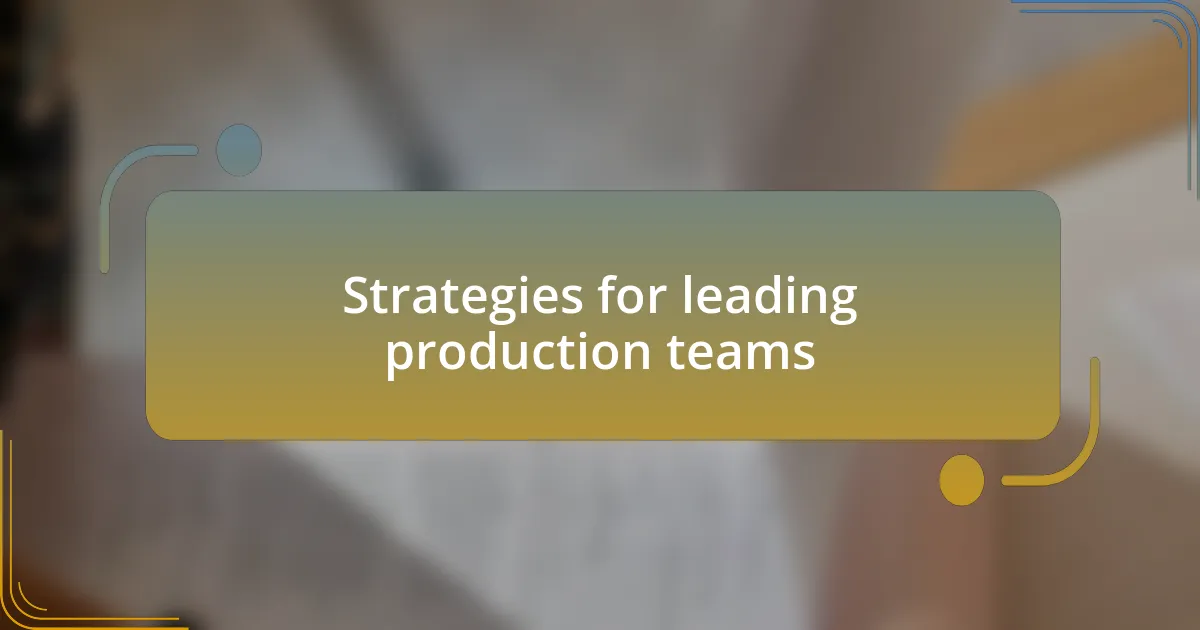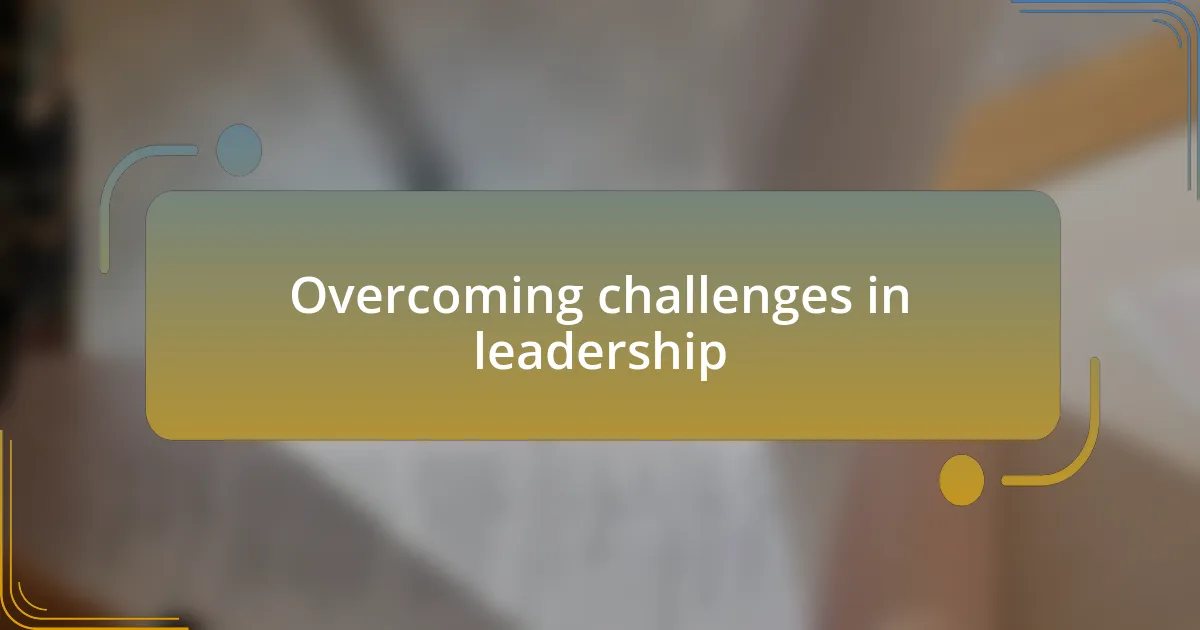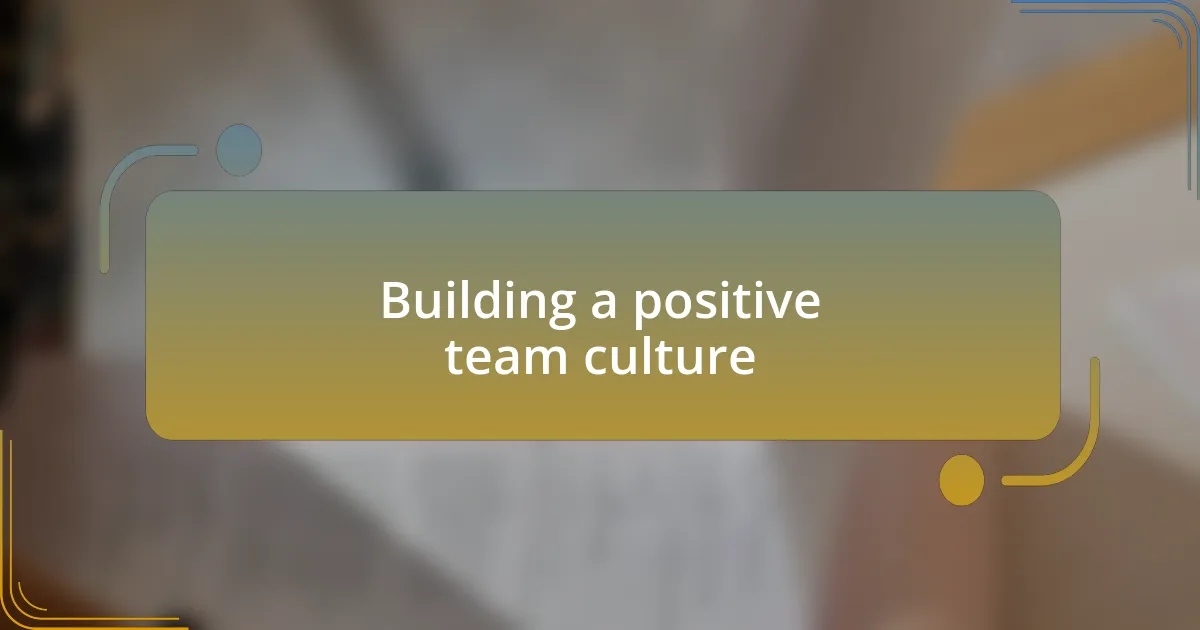Key takeaways:
- Effective film production leadership requires balancing creative vision with clear communication, fostering collaboration and trust within the team.
- Key qualities of effective leaders include empathy, adaptability, and transparency, which help maintain team morale and foster a problem-solving culture.
- Strategies like effective communication, delegation, and encouraging shared experiences promote accountability and connection among team members.
- Building a positive team culture through recognition and informal interactions enhances collaboration, creativity, and overall morale in film production settings.

Understanding leadership in film production
In my experience, understanding leadership in film production is about balancing creative vision with practical execution. I remember a time when a director had a brilliant concept but struggled to communicate it effectively to the team. This taught me how essential clear communication is in fostering an environment where everyone feels engaged and understood.
Leadership in this field goes beyond just making decisions; it involves inspiring trust and fostering a collaborative atmosphere. Reflecting on my journey, I’ve noticed that great leaders in production don’t just dictate; they listen. Have you ever wondered how a leader can transform a chaotic set into a harmonious team? I’ve seen it happen through active engagement and support, allowing everyone to bring their best work forward.
Being a leader also means recognizing and adapting to the unique dynamics of your crew. I recall working with a producer who carefully considered each member’s strengths and weaknesses, tailoring their approach to bring out the best in everyone. This personal touch not only improved productivity but also built a sense of camaraderie. Isn’t it fascinating how understanding individuals can lead to a stronger collective output?

Key qualities of effective leaders
Effective leaders in film production possess a unique blend of vision and empathy. I once worked alongside a line producer who could almost read the room. When tensions rose during a long shoot, she would sense the fatigue in the team and instead of pushing harder, she’d call for a break, allowing everyone to recharge. This instinctive understanding of team morale not only boosted our energy but also reaffirmed our trust in her leadership.
Another critical quality is adaptability. I’ve encountered situations where unforeseen challenges, like bad weather or last-minute script changes, threatened to derail our plans. A director I once worked with embraced these moments as opportunities rather than setbacks. His ability to think on his feet and adjust the shooting schedule not only kept the project on track but also encouraged the crew to remain flexible and innovative. Have you ever noticed how a leader’s response to challenges can set the tone for the entire team?
Moreover, transparency is vital. I remember a project where the budget constraints were tight, and instead of hiding these facts, the producer openly shared the constraints with us. This honesty fostered a spirit of problem-solving among the crew. When everyone understands the bigger picture and contributes to finding solutions, it cultivates a strong sense of ownership and commitment. Isn’t it inspiring how transparency can transform obstacles into collective challenges?

Strategies for leading production teams
Effective communication is one of the most important strategies for leading production teams. I recall a time when we were on a tight shooting schedule, and the entire crew had different interpretations of the director’s vision. During a quick team meeting, the director clarified his expectations by sharing storyboards and references. This not only aligned everyone’s understanding, but it also sparked a renewed sense of excitement among the crew. Have you ever felt how a clear direction can turn confusion into collaboration?
Another valuable strategy is fostering a collaborative environment. I remember a project where we implemented a daily check-in, allowing each team member to voice their progress and challenges. This simple practice not only built camaraderie, but it also granted everyone a sense of accountability. Seeing how our small victories and struggles were shared reinforced our connection and commitment to each other’s success. How often do we underestimate the power of shared experiences within a team?
Delegating tasks effectively is equally critical. On one production, I observed an assistant director who freely entrusted responsibilities to different crew members, recognizing their strengths. His approach not only empowered individuals but also encouraged a strong sense of ownership in their roles. By allowing team members to take the lead in their areas of expertise, I witnessed a remarkable boost in creativity and efficiency. Isn’t it fascinating how trust in your team can unlock their full potential?

Overcoming challenges in leadership
Leadership in a production environment inevitably brings challenges, especially when team dynamics come into play. I recall a particularly tense day on set when a conflict arose between two key crew members. Tensions were high, and the atmosphere felt charged. I approached both of them separately and encouraged them to air their grievances. This openness turned a potential disaster into an opportunity for growth, allowing them to find common ground. Have you ever faced a situation where conflict turned into collaboration through honest conversation?
Another challenge is navigating differing skill levels within a team. On one project, I had a mix of seasoned professionals and newcomers, which created a natural imbalance in confidence and ability. To bridge this gap, I organized informal knowledge-sharing sessions where the veterans could mentor the less experienced crew members. This built trust and respect and also enhanced the overall skill set of the team. Isn’t it remarkable how empowering someone can lead to collective advancement?
Moreover, there are moments when leadership feels incredibly isolating. During a hectic week of shooting, I found myself making tough decisions that not everyone agreed with. I remember taking a deep breath and reminding myself that transparency is key. I held a team meeting where I explained my reasoning and encouraged feedback. This vulnerability not only fostered a sense of trust but also made the team feel like valued contributors to the project. How often do we underestimate the power of inviting open dialogue in leadership?

Personal experiences with film leadership
Reflecting on my experiences as a leader in film production, one particular project stands out. I was tasked with directing a short film where I had to manage a diverse group of creatives, each with their unique vision. During one brainstorming session, I noticed that one team member felt overshadowed by louder voices in the room. I encouraged her to share her ideas, and as she spoke, the room shifted. It was a powerful reminder that inclusive leadership can uncover hidden gems. Have you ever seen a quiet voice make waves?
In another instance, I led a team where time was our greatest enemy. The schedule was tight, and I could feel the mounting pressure. Instead of simply pushing for results, I gathered everyone for a candid talk. I asked how we could tackle the deadlines together. The forthcoming solutions sparked a renewed sense of ownership among the team members. It taught me that sometimes, asking for input can ignite creativity and motivation in even the grimmest of situations. Have you ever found that the best ideas come from those you least expect?
I often reminisce about a time when failure seemed imminent during pre-production. Our lead actor had to drop out just days before filming. It was a testing moment that threw the entire team into panic. I decided to hold a roundtable discussion, fostering an atmosphere of collaboration rather than despair. We brainstormed alternatives, and in the end, a team member who was initially a grip stepped up to take on the lead role. It was a true lesson in resilience and flexibility, showing me that leadership is not just about making decisions but also about empowering others to step outside their comfort zones. Isn’t it amazing how challenges can lead to unexpected breakthroughs?

Building a positive team culture
Creating a positive team culture is essential in production settings. I can recall a time when our film project hit a snag due to miscommunication. Recognizing the tension, I organized informal coffee breaks, allowing everyone to connect outside of the usual script discussions. Suddenly, team dynamics transformed, bridging gaps and fostering camaraderie. Have you ever noticed how a simple conversation can ease tension and spark creativity?
In another project, we held regular “appreciation huddles,” where team members thanked one another for specific contributions. It was heartwarming to see the joy on people’s faces when they received recognition for their hard work. This practice not only improved morale but also encouraged more collaboration. Do you think acknowledging effort can elevate a team’s spirit?
The power of shared experiences cannot be underestimated in building a positive culture. I remember organizing team-building activities, like a mini film festival showcasing our own short pieces. Watching our projects together created a sense of unity and pride among us. It was a striking reminder of how a strong team spirit can propel our creativity to new heights. How do you think shared moments influence a team’s ability to collaborate effectively?